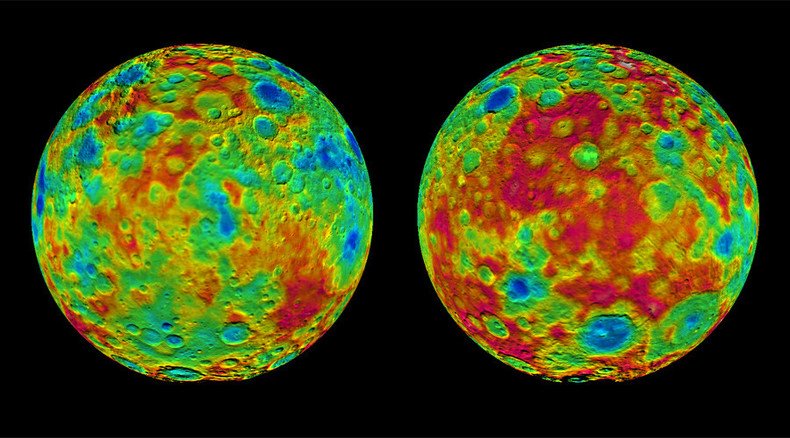Dwarf planet Ceres' mysterious 'bright spots' mapped by NASA's Dawn probe

“Dawn is about to make history” said project manager Robert Mase as the spacecraft headed toward the dwarf planet. NASA has just released images taken during the mission that reveal a diverse topography filled with craters, peaks and ridges.
Ceres is the largest object in the asteroid belt between Mars and Jupiter, and the only one to have been rounded by its own gravity. Even so, it’s tiny compared to Earth. It has an average diameter of about 590 miles (950 kilometers), and has a surface area that’s only about 38% the size of the continental United States. The dwarf planet is covered with a thin layer of dust that hides a vast ocean underneath. Scientists speculate whether the ocean is completely frozen or not.
But the most interesting thing about Ceres is the so-called “bright spots” that have been witnessed through telescopic information as well as pictures taken during the Dawn mission.
These strange features of Ceres’ surface could help scientists discover the origins of our solar system. According to Jim Green, director of NASA's Planetary Science Division, quoted by the NASA Jet Propulsion Laboratory website: "Studying Ceres allows us to do historical research in space, opening a window into the earliest chapter in the history of our solar system. Data returned from Dawn could contribute significant breakthroughs in our understanding of how the solar system formed."
The current images produced by the Dawn mission show myriad craters from asteroid impacts as well as signs of previous geological activity, such as landslides. Taking from the tradition of naming celestial bodies after figures from mythology, the craters on the surface of Ceres are named after agricultural deities (Ceres is the Greek goddess of the Harvest). The crater where the “bright spots” come from is called Occator after the Roman god of harvest and harrowing.
READ MORE: 3-mile high ‘pyramid peak’ spotted on mysterious Ceres dwarf planet
Currently, Dawn is spiraling toward Ceres for the third time on its mission. By mid-August it will come closer to the dwarf-plant than ever before, positioned just 900 miles above the surface. Scientists hope that this time the spacecraft will be able to snap some pictures that solve the mystery of the “bright spots” once and for all.












